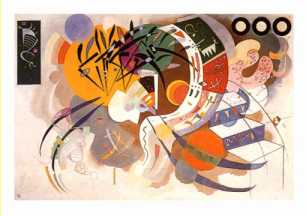 W. Kandinsky, Dominant Curve, 1936
W. Kandinsky, Dominant Curve, 1936
Back to Main Page | |||||
|
Favorite Sites |
Computing |
Education |
News |
Jobs |
Israel |
|
Business |
W3 Resources |
History |
Travel |
Internet |
Russia |
|
Entertainment |
Books |
Art |
Science |
Languages |
Spanish |

 W. Kandinsky, Dominant Curve, 1936
W. Kandinsky, Dominant Curve, 1936
 Chado (The Way of Tea)
experienced its prime during the the 16th century under the influence of the
artist Sen Rikyu(1522 - 1591). The tea ceremony provided a venue and practice
for recognizing the beauty of ordinary life. The aesthetic character of the
ceremony was defined as wabi, or a rustic, simple quality -- a celebration of
the humble aspects of life.
Chado (The Way of Tea)
experienced its prime during the the 16th century under the influence of the
artist Sen Rikyu(1522 - 1591). The tea ceremony provided a venue and practice
for recognizing the beauty of ordinary life. The aesthetic character of the
ceremony was defined as wabi, or a rustic, simple quality -- a celebration of
the humble aspects of life.
The basic idea of , or tea ceremony, is by four Chinese characters, WA( ),
KEI(
),
KEI( ), SEI(
), SEI( ,
and JAKU(
,
and JAKU( ). WA means
harmony, KEI means respect, SEI means purity, and JAKU means tranquillity.
Harmony can be formed among all matters in the world such as people, flowers,
tea bowls, and so on. In fact, in a tea gathering, people talk to each other
and to every piece of equipment a host uses in silence to form harmony in a tea
room. People must respect all matters without their status; that is, people
must not discriminate. For example, people use a crawl-through doorway to enter
a tea room, so even a person who has a high social status has to lower his or
her head to enter in although he usually lower his head. Purifying spirits is
very important since the ideal spirit of the ceremony is a sort of religious
mind. Then, after people can get the three ideas, harmony, respect, and purity,
people can finally embody tranquillity.
). WA means
harmony, KEI means respect, SEI means purity, and JAKU means tranquillity.
Harmony can be formed among all matters in the world such as people, flowers,
tea bowls, and so on. In fact, in a tea gathering, people talk to each other
and to every piece of equipment a host uses in silence to form harmony in a tea
room. People must respect all matters without their status; that is, people
must not discriminate. For example, people use a crawl-through doorway to enter
a tea room, so even a person who has a high social status has to lower his or
her head to enter in although he usually lower his head. Purifying spirits is
very important since the ideal spirit of the ceremony is a sort of religious
mind. Then, after people can get the three ideas, harmony, respect, and purity,
people can finally embody tranquillity.
The host kneels at the door of the teahouse, while guests wash their hands before entering, leaving shoes and weapons outside. The guests then kneel before the tokonoma, an shelf-like arrangement that serves as a physical center for the ceremony.
The host brings in the simple tea wares and displays everything, and the guests may take leave while the preparations are continued. When the water boils, the guests are called back with a gong and given food and possibly sake.
The powdered tea (it is called macha) is placed in the tea bowl and covered with hot, not boiling, water. After being beaten into a froth with a tea whisk, the drink is passed to the chief guest who imbibes and passes the bowl to the next guest, and so it continues.
In the past, the host may have given away all of the tea wares and tea making implements, except the bowl-which would be kept and then broken to symbolize the end of the ceremony.
The sencha tea ceremony was advocated by the famous tea-seller Baisa-o(literally, the venerable Tea-seller) and became popular among literary artists called bunjin(literally, "cultured person"), who prized freedom under the hierarchical feudal system of the period. Tea played an important role in fostering communication and friendship among them. As a result, although the sencha tea ceremony became a ritual, it much less formal than cha-no-yu.
The garden contains a wash basin, or Tsukubai. The Tsukubai is surrounded by Yaku-ishi, or (literally "accompanying stones"); one in front used for standing on, one on the right, and one on the left. The basin itself can be any shape, as long as it can be easily used. In fact, broken stone lanterns are often put to use as new wash basins. The tea garden also contains a resting place, for breaks in the tea ceremony. This resting area was not in the original tea gardens. The resting place's principal purpose, is to convey the spirit of wabi, or quiet solitude in nature.
 Tea in Japan
Tea in Japan
 Tea Museum
Tea Museum
 TeaHyakka
TeaHyakka
 Tea Gardens
Tea Gardens